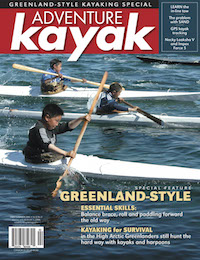“I want to sleep on a sandy beach!”
Jenny’s voice, one part joking plea, two parts whining 10-year-old, drifted up to me from the back of the group. Until now, on our fourth day, the usually desk- bound paddlers I was guiding north of nootka sound had been the picture of contentment, enjoying the kayaking life to its fullest. and I had successfully dodged the sandy bullet. but that rest- less look had come creeping into everyone’s eyes today, caribbean visions of holidays past dancing in their heads.
I’m no mere sun-worshipping beachgoer, you see, able to toss a gritty towel and umbrella into the trunk of my car and drive home to a cleansing shower and a vacuum cleaner. I live and work in the outdoors. and I know what I like.
Experience is a great teacher in the wilderness, and I’ve had my share. sand gets everywhere—under your fingernails, between your toes, and in your fresh fish dinner. ever try to get sand off of a slice of cheese?
I’ve found sand bunched in and breaking the bindings of my field guides, grinding the threads of the cap of my water bottle, and I personally have two chipped molars as a result of sand in my food.
Sand sticks to your feet and under your socks, piles up at the bottom of sleeping bags and falls out of your hair onto the pillow when you’re sure you’ve kept your head out of the ground that day.
Sand chafes under the straps of your sandals, binds up the tent zippers, and gets buried under the flap of skin created by blisters.
It sticks to your sunscreen like feathers to tar.
It jams up paddles and tent poles alike, irritates under your heels while you sit in the kayak, and crusts into your eyes in the wind—I once pulled silt out of the corners of my eyes for fully two days after a windstorm on an arctic river. Dandruff? No, it’s just sand. Foggy? Nope, it’s the grit in my sunglasses!
I prefer stones. Small, smooth, round stones. Cobblestones. Like the ones, say, just north of the Robson Bight Ecological Reserve in Johnstone Strait, in some of the coves in the Nuchatlitz Islands on western Vancouver Island, or all along the coast of Lake Superior Provincial Park. Cobblestone beaches are forgiving. They are developed in character, having both the courtesy and common sense to remain in their place on the ground when trodden on, and not attempt to hitch a ride to destinations unknown.
I have long suspected, but been unable to prove, the greater self-confidence of rocks as opposed to their more bro- ken-down colleagues, the grains of sand. No need to invade your space uninvited, no personality trait that sets them to wandering when all is well in the place they have just left. A commitment to the beach, perhaps.
Sand can claim no such integrity.
The fact that stones are morally superior, so to speak, is amply demonstrated among the small- to medium-sized cousins that I prize the most for sleeping beaches. Their sense of hospitality is refined to the point where they actually mould themselves to your body ensuring a good night’s rest. Unlike displacing a bed in a pliable cushion of stones, trying to mould a bed in sand is more like making a form in concrete.
“Aren’t there any beautiful sunset-facing beaches around here?”
Inwardly sighing, I mustered a smile and turned around to answer Jenny. “Sure there are!” I said. Hey, the customer is always right. You do what you must to make the trip work, but I know where my heart lies. It’s nestled in the hollow of a warm, smooth rock.
Rick Snowdon is a guide, traveller, freelance writer and occasional student. He divides his time between Quadra Island, British Columbia, and Thunder Bay, Ontario.




